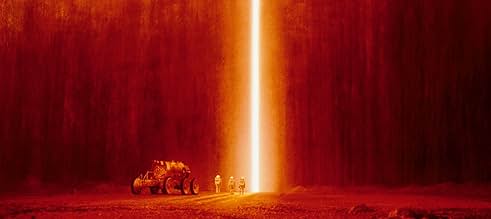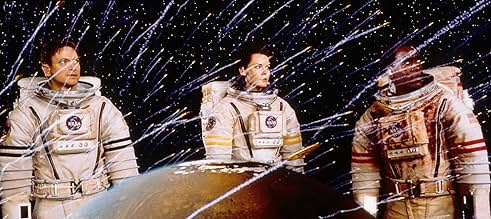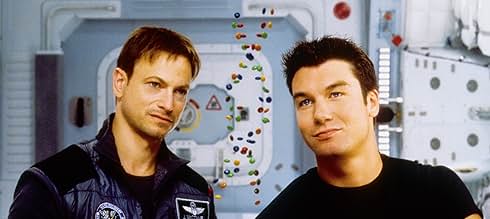When the first manned mission to Mars meets with a catastrophic and mysterious disaster after reporting an unidentified structure, a rescue mission is launched to investigate the tragedy and... Read allWhen the first manned mission to Mars meets with a catastrophic and mysterious disaster after reporting an unidentified structure, a rescue mission is launched to investigate the tragedy and bring back any survivors.When the first manned mission to Mars meets with a catastrophic and mysterious disaster after reporting an unidentified structure, a rescue mission is launched to investigate the tragedy and bring back any survivors.
- Awards
- 3 nominations total
- Child at Party
- (as Jeff Ballard)
Featured reviews
Brian De Palma's film is about how the first manned mission to Mars goes very wrong thanks to a catastrophic and somewhat mysterious event. A rescue team goes to Mars to see if anyone is alive and they discover something that may enchant them forever.
This film has a pretty good cast and it seems like they had a good time. I don't see much of Gary Sinise anymore, but he does a good job as Jim. Don Cheadle is awesome as always. I can't complain about Tim Robbins since he usually does a good job in anything. All in all, everyone has good chemistry here.
Overall, this is a decent, wonder-inspiring sci-fi film. It may not be perfect thanks to some corny dialogue and some times of slowness, but it's much better than what people give it credit for. It's also a film that gives a possible view on where we people from Earth came from. I can't believe people say Morricone's score is bad, but it's far from bad. It's a haunting, stylish score that will stick with you, just like the movie. I rate this film 8/10.
Sure, "MTM" steals from lots of other movies, but what film doesn't? The opening is lifted directly from "Apollo 13", but it serves the purpose of setting everything up rather painlessly. I love the cast, and they do establish a sense of camaraderie here.
I am not an aeronautical engineer, but I do know enough science to appreciate the way the fight to survive the entry into Mars' atmosphere is based on the limitations of their equipment. In most action movies, the hero has limitless ammo, fuel, food, etc. It was truly heartbreaking to see Tim Robbins' character make the choice he did.
Overall, "Mission to Mars" is very enjoyable. It felt like a short story lifted directly out of the Sci-Fi of the 60's, which I grew up reading. The pacing is very good, the acting is good (given some of the cliched situations), the script does not insult your intelligence, and I liked the resolution very much. Fun at the movies, what more can you ask?
The film stars such veteran actors as Tim Robbins, Gary Sinise, Don Cheadle, and Jerry O'Connell; an ensemble where only first-class acting is possible. So let us move onto the direction. It is Brian DePalma's foray into science fiction. And masterfully done to say the least. His shot composition is reminiscent of Scarface and The Untouchables, mixing filmmaking from the days of yore with today's MTV aesthetic. DePalma's talent for filming suspenseful action sequences is in full swing in this film. The spacewalk scene will be one that will not be forgotten for quite some time. Could possibly be one of the best spacewalk scenes in films to date. The hidden jewel for me was the unpredictability of the film. Each corner turned was a pleasant surprise. I can't remember that last time I saw a movie with this quality, especially coming out of the Hollywood mainstream.
The cinematography was astounding. Imagine Lawrence of Arabia lensed on Mars. Professor Jenkins from Scientific America was correct when he said that the images from the film were identical to those photographed from the actual planet. And that is not a small feat.
"Mission to Mars" introduces its playful intentions with its very first shot. A toy rocket, accompanied by carnival music, shoots up into the air and explodes. De Palma is here to play with his toys. The very next scene is an overly elaborate long-take in which all the film's characters, their loves and losses, are introduced.
As a formalist, De Palma often calls attention to the artificiality of art. Here he has two astronauts holding video cameras as a CGI beast veers toward them. We focus on Don Cheadle's eyes as he watches these two film-makers, the word "synthetic" stencilled in bold letters behind him. This whole action scene is fake, created for the audience. De Palma wants you to focus not on story, but the design and look of the thing. Likewise, the aliens at the end of the film are themselves artists who've designed man. As such, they demonstrate this knowledge to their audience (the astronauts) with a "film".
De Palma once said that space travel and scientific conquest are the only things that he can generate genuine optimism for, and one feels this in "Mission to Mars". The film has an overwhelming sense of earnestness. De Palma characters have never seemed so pure, optimistic, good natured and filled with humanity. There's no cynicism or bitterness here. Upon first viewing I found this all very cheesy, but now, coupled with Ennio Moricone's sweeping and romantic score, I find the film's broad brushstrokes very moving.
"Mission" also continues De Palma's trend of turning classic films on their side. He's done this to Hitch, Fellini, Anotonioni and Hawks. Now he does it to Kubrick (one scene literally has "2001: A Space Odyssey's" monolith on it's side).
Does this make De Palma a hack? No, It makes him a giddy delight if you're a film fan. "Mission to Mars" is a bit more straightforward than "2001," it's a little friendlier, but it's practically the same movie. Just replace the monolith with the "Mars face," and drop Hal. Both films' spaceships also look alike, and the white room used in the climactic scene strongly resembles the room at the end of "2001." And of course, where Kubrick gave us spaceships dancing the waltz, De Palma gives us astronauts dancing in zero gravity.
But De Palma doesn't stop at Kubrick. His film has a character named Luke who spends one scene talking about a mysterious "force" (Star Wars), a spaceship commanded by a man named Jim (Star Trek), and many overt reference to "Flash Gordon", "Robinson Crusoe" and "Teasure Island". Noticing that his tale is a virtual rehash of "The Abyss", De Palma also tips his hat to James Cameron by having Gary Sinese become submerged in oxygenated water (like Ed Harriss) during the film's finale. And of course both films have a CGI tentacle. Cameron gives us water, De Palma gives us sand.
Everything De Palma touches has been covered before. He acknowledges this. But it's how he touches, that's magical. His entire film is elegant and fluid. Every shot is just a little bit wider or closer than usual. His camera pans and tracks with robotic precision, dancing, points of views shifting, perspectives changing. There's a perfection in his form. Every shot is beautifully precise.
But what about the trite story, critics say? Yes, the story is silly, stupid even, but it's all told with such an earnest "awww shucks" feeling that it sucks you in. And besides, De Palma is never about story. Compare "Femme Fatale" to "Double Indemnity". "Compare Vertigo" to "Body Double" or "Obsession". He takes the core ideas of all these films and multiplies them by ten. You want "Double Indemnity"? De Palma gives you triple indemnity. You want Hitchcockian voyeurs? Hell, De Plama's voyeurs are watching voyeurs who themselves are being watched by even more voyeurs. You want illicit Hitchcockian affairs? Screw that. De Palma gives you Vertigo with incest. You want a slow-mo Hitchcock knife stab? Hell, De Palma kills you with a power drill and chainsaw.
Nothing in De Palma's cinema is real. He knows that all films are about other films. Everything he's done has been done before. This is what all formalists (Coens, Tarantino, Leone) are about. They're interested in the act of watching and how we catalogue what we see.
After 4 viewings, the only flaw I see in "Mission to Mars" is the film's unimaginative ending. Someone concerned with style and superficial form really should design a more imaginative ending. De Palma's silly alien hologram feels hokey, though Morricone's score does lend it an emotional sweep.
But this fault, I think, can be blamed on Touchstone. The studios had an 80 million dollar budget on the line, and weren't happy with where the film was going. They wrongly thought they had another Appolo 13/Gary Sinese rescue movie on their hands. And so looking to save cash, they chopped the budget and gave De Palma several months less to shoot the final act. Hence the film goes nowhere after the EVA sequence. But this sort of studio meddling is typical with De Palma (Snake Eyes, Mission Impossible, Casualties, Dahlia, Obsession, Bonfire etc were all taken away at some point).
8.5/10- The film has aged well. Gorgeous visuals, beautiful music and an affecting sense of optimism. The only flaw is the last act, which still works thanks to Morricone's score and an emotional flashback montage. Requires several viewings.
Did you know
- TriviaThe filmmakers created the Martian landscape in a massive sandpit near Vancouver. It was one of the biggest sets ever constructed for a movie - around two million square feet.
- Goofs(at around 1h 18 mins) While looking at a DNA sequence Terri Fisher says that the last two chromosomes are missing. What is missing is actually the last two nucleotides of the sequence. DNA does not have chromosomes. Rather, chromosomes are comprised of DNA, and a single chromosome will contain many tens or hundreds of millions of nucleotides.
- Quotes
Terri Fisher: The genetic difference between men and apes is only three percent. But that three percent gave us Einstein, Mozart...
Phil Ohlmyer: ...Jack The Ripper.
- Crazy creditsThe National Aeronautics and Space Administration's cooperation and assistance does not reflect an endorsement of the contents of the film or the treatment of the characters depicted therein.
- ConnectionsFeatured in Late Night with Conan O'Brien: Lisa Rinna (2000)
- SoundtracksMa 'Tit Fille
Written by Buckwheat Zydeco (as Stanley Dural, Jr.)
Performed by Buckwheat Zydeco
Courtesy of The Island Def Jam Music Group
By arrangement with Universal Music Special Markets
Everything New on Hulu in July
Everything New on Hulu in July
Details
- Release date
- Countries of origin
- Official site
- Language
- Also known as
- Misión a Marte
- Filming locations
- Production companies
- See more company credits at IMDbPro
Box office
- Budget
- $100,000,000 (estimated)
- Gross US & Canada
- $60,883,407
- Opening weekend US & Canada
- $22,855,247
- Mar 12, 2000
- Gross worldwide
- $110,983,407
- Runtime1 hour 54 minutes
- Color
- Sound mix
- Aspect ratio
- 2.39:1
- 2.35 : 1
Contribute to this page


































